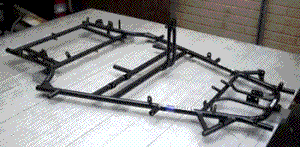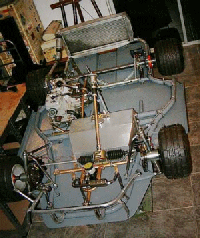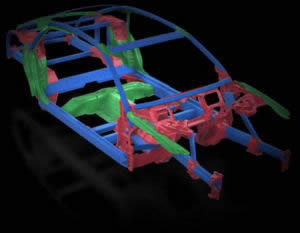Chassis explained
As you design a racing car, it is important that you know the requirements of your engineering work. The nature of the race car's normal operation and fatigue life depend on the structure and material composition of the car. Therefore, topics such as metallurgy and structural design are important for the designer to grasp. The whole concept of engineering considerations is that you keep in mind four aspects, where they are appropriate:
Any good chassis must do several things:
- Be structurally sound in every way over the expected life of the car and beyond. This means that nothing will ever break under normal conditions.
- Maintain the suspension mounting locations so that handling is safe and consistent under high cornering and bump loads. This means that there is no flexing of the body, or at least to reduce flexing on lowest possible value.
- Support the body panels and other components so that evevrything feels solid and has a reliable life span.
- Protect the driver from external intrusion.
Structural stiffness is the basis of what you feel at the seat of your back bottom. It defines how a car handles, body integrity, and the overall feel of the car. Chassis stiffness is what separates a great car to drive from what is merely OK.
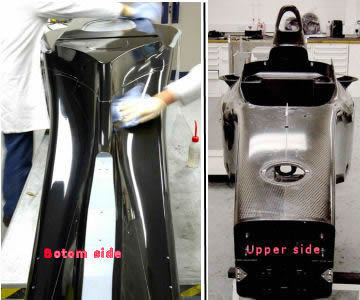 Contrary to some explanations, there is no such thing as a chassis that doesn't flex, but some are much stiffer than others. Even highly sophisticated Formula 1 chassis (actually, Formula 1 has monocoque structure) flex, and sometime some limited and controlled flexing is built in the car.
Contrary to some explanations, there is no such thing as a chassis that doesn't flex, but some are much stiffer than others. Even highly sophisticated Formula 1 chassis (actually, Formula 1 has monocoque structure) flex, and sometime some limited and controlled flexing is built in the car.
The range of chassis stiffness has varied greatly over the years. Basic chassis designs each have their own strengths and weaknesses. Every chassis is a compromise between weight, component size, complexity, vehicle intent, and ultimately, the cost. And even within a basic design method, strength and stiffness can vary significantly, depending on the details.
There is no such thing as the ultimate method of construction for every car, because each car presents a different set of problems.
Some think an aluminium chassis is the path to the lightest design, but this is not necessarily true. Aluminium is more flexible than steel. In fact, the ratio of stiffness to weight is almost identical to steel, so an aluminium chassis must weigh the same as a steel one to achieve the same stiffness. Aluminium has an advantage only where there are very thin sections where buckling is possible - but that's not generally the case with tubing - only very thin sheet. And even then, aircraft use honeycombed aluminium to prevent buckling. In addition, an aircraft's limitation is not stiffness, but resistance to failure. Aluminium problems are overcomed something with Audi Aluminium Spaceframe (ASF), very expensive and for now made in limited models. Read about that later in this article.
Let’s see some chassis basic construction methods from the past and from today. I will explain a bit more two designs employed more in racing: Spaceframe and Monocoque (in different article about monocoque in Formula 1)
Ladder Chassis (Body on frame technology)
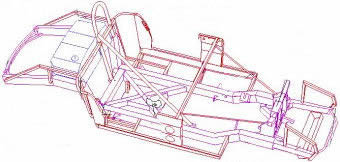
This is the earliest kind of chassis. From the earliest cars until the early 60s, nearly all cars in the world used it as standard. Even in today, most SUVs still employ it. Its construction, indicated by its name, looks like a ladder - two longitudinal rails interconnected by several lateral and cross braces. The longitude members are the main stress member. They deal with the load and also the longitudinal forces caused by acceleration and braking. The lateral and cross members provide resistance to lateral forces and further increase torsional rigidity. Since it is a (little bit more than) 2 dimensional structure, torsional rigidity is very much lower than other chassis, especially when dealing with vertical load or bumps.
This technology you can find today in some basic auto racing categories. Most known is kart. On picture below you can see chassis of an Superkart car without bodywork.
was of this type of construction. There was nothing particularly big or clever about the Ferrari 500. It was simply a reworked version of the Scuderia's previous F2 car: a ladder chassis with transverse leaf springs up front and a De Dion axle at the rear, now located by trailing arms, but with a simpler and much more effective V12 engine, and this architecture would remain a mainstay of the Ferrari range for years to come, but in two-litre form it had been well beaten in F2. Ferrari 500 won every world championship grand prix from May 1952, until Maserati racer Juan Manuel Fangio broke its run at Monza on September 13 1953. Official "500" was competing from in 18 races, with 14 wins (77,78%).
Backbone chassis
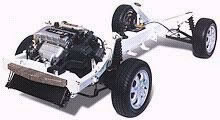 |
Lotus Elan Backbone chassis rectangular in cross section |
Backbone chassis is a type of a car construction chassis that is similar to the ladder design. Instead of a two-dimensional ladder type structure, it consists of a strong tubular backbone (usually but not always rectangular in cross section) that connects the front and rear suspension attachment areas. The tunnel or backbone becomes a primary load bearing member.
Backbone chassis is very simple: a strong tubular backbone connects the front and rear axle and provides nearly all the mechanical strength.
 |
Skoda Rahmen with tubular backbone |
Inside backbone is space for the drive shaft in case of front-engine, rear-wheel drive layout like in the case of Lotus Elan. The whole drivetrain, engine and suspensions are connected to both ends of the backbone. A body is then placed on this structure.
It is almost a trademark design feature of Czechoslovak Tatra heavy trucks (cross-country, military etc.), but this type of chassis is also often found on small sports cars. It also does not provide protection against side collisions, and has to be combined with a body that would compensate for this shortcoming.
Spaceframe
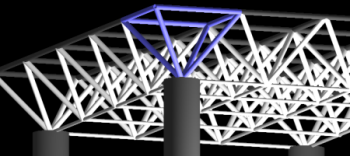
The two most important goals in the design of a race car chassis are that it be lightweight and rigid. Lightweight is important to achieve the greatest acceleration for a given engine power. Rigidity is important to maintain precise control over the suspension geometry, that is, to keep the wheels firmly in contact with the race course surface. Unfortunately these two goals are often in direct conflict. Finding the best compromise between weight and rigidity is part of the art and science of race car engineering.
As ladder chassis was not strong enough, and provide small rigidity values, motor racing engineers developed a 3 dimensional design - Tubular space frame.
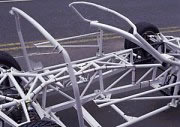
The spaceframe chassis is about as old as the motorsport scene. Its construction consists of steel or aluminum tubes placed in a triangulated format, to support the loads from suspension, engine, driver and aerodynamics. A true space frame has small tubes that are only in tension or compression - and has no bending or twisting loads in those tubes. That means that each load-bearing point must be supported in three dimensions.

Tubular space frame chassis employs dozens of circular-section tubes (some may use square-section tubes for easier connection to the body panels, though circular section provides the maximum strength), position in different directions to provide mechanical strength against forces from anywhere. These tubes are welded together and form a very complex structure, as you can see in the left picture.
For higher strength required by high performance sports cars, tubular space frame chassis usually incorporate a strong structure under both doors, hence result in unusually high door sill and difficult access to the cabin.
In the early 50s, Mercedes-Benz created a racing car 300SLR using tubular space frame. This also brought the world the first tubular space frame road car, famous 300SL Gullwing. Since the door sill dramatically reduced the accessibility of cabin, Mercedes had to extend the doors to the roof so that created the "Gullwings".
Since the mid 60s, many high-end sports cars also adopted tubular space frame to enhance the rigidity / weight ratio. However, many of them actually used space frames for the front and rear structure and made the cabin out of monocoque to cut cost.
There are also some inherent advantages to using spaceframes at the amateur level of motorsport as well. Spaceframes, unlike the monocoque chassis used in modern Formula 1 or CART, are easily repaired and inspected for damage.
How does triangulation work? The diagram below shows a box, with a top, bottom and two sides, but the box is missing the front and back. The box when pushed collapses easily because there is no support in the front or back.
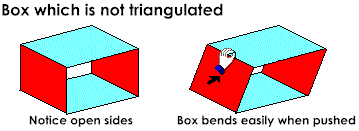
Of course, race cars (or any other car for that matter) need to be supported in order to operate properly, and so we triangulate the box by bracing it diagonally. This effectively adds the front and back which were missing, only instead of using panels, we use tubes to form the brace. See below:
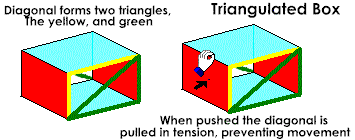
The triangulated box above imparts strength by stressing the green diagonal in Tension. Tension is the force trying to pull at both ends of the diagonal. Another force is called Compression. Compression tries to push at both ends of the diagonal (Shown above in the horizontal yellow tube). In a given size and diameter tube or diagonal, compression will always cause the tube to buckle long before the same force would cause the tube to pull apart in tension. As an experiment, try pulling on the ends of a pop can, one end in each hand. Then, try crushing the can by pushing on both ends. The crushing is much easier, or at least humanly possible, compared to pulling the can apart.
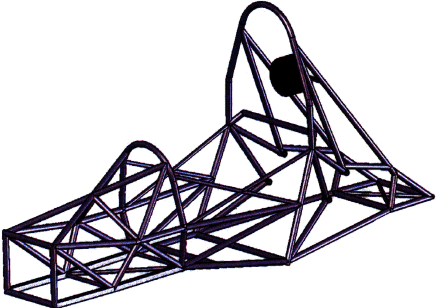
Spaceframes are really all about tubes held together in compression and tension using 3D pyramid-style structures, and diagonally braced tube boxes. A true spaceframe is capable of holding its shape, even if the joints between the tubes were hinges. In practice, a true spaceframe is not practical, and so many designers "cheat" by using stronger materials to support the open portions of the structure, such as the cockpit opening.
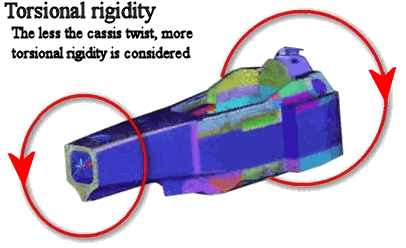 Torsional rigidity applies to spaceframes too, but because a spaceframe isn't made from continuous sheet metal or composite panels as in monocoque design, the structure is used to approximate the same result as the difficulty to twist "cigar car" (read below).
Torsional rigidity applies to spaceframes too, but because a spaceframe isn't made from continuous sheet metal or composite panels as in monocoque design, the structure is used to approximate the same result as the difficulty to twist "cigar car" (read below).
Another reason torsional rigidity is mentioned here is that it greatly affects the suspension performance. The suspension itself is designed to allow the wheels/tires to follow the road's bumps and dips. If the chassis twists when a tire hits a bump, it acts like part of the suspension, meaning that tuning the suspension is difficult or impossible. Ideally, the chassis should be ultra-rigid, and the suspension compliant.
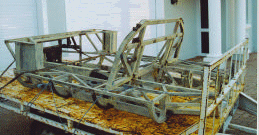 |
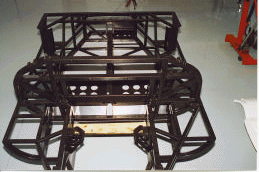 |
It is important to ensure that the entire chassis supports the loads expected, and does so with very little flex.
Advantage of spaceframe is that is very strong in any direction compared with ladder chassis and metal monocoque chassis of the same weight. Disadvantage is that is very complex, costly and time consuming to be built. Impossible for robotized production. Besides, it engages a lot of space, raise the door sill and result in difficult access to the cabin.
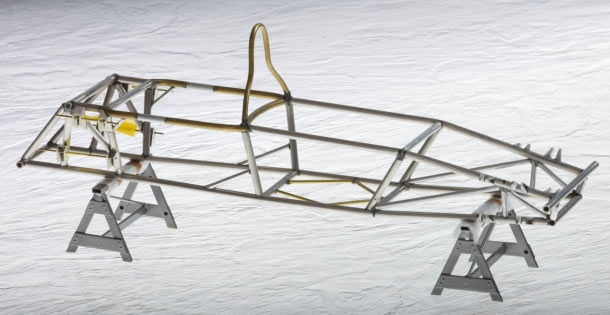
Ferrari 156 Sharknose spaceframe
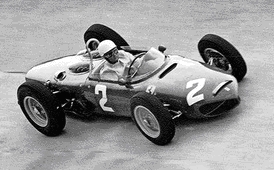 Ferrari 156 'sharknose' was the first Ferrari Formula 1 car to win the constructors' championship, and first competitive Ferrari F1 with rear drive. It also carried Phil Hill to the 1961 title after the death of team-mate Wolfgang von Trips in the Italian Grand Prix at Monza.
Ferrari 156 'sharknose' was the first Ferrari Formula 1 car to win the constructors' championship, and first competitive Ferrari F1 with rear drive. It also carried Phil Hill to the 1961 title after the death of team-mate Wolfgang von Trips in the Italian Grand Prix at Monza.
Over the winter of 1959, Ferrari's engineers, led by Carlo Chiti, laboured in secret. Over the winter, F1 downsized to 1.5 liters, catching out British teams. And Enzo had a car and engine ready to go. Chiti's 156 was a wishbone-suspended tube-frame chassis (pictures), evolved from the 246P but slimmer in profile. This made it better able to minimise air-resistance with less power pushing the car. To maximise that advantage and reduce the centre of gravity, Chiti flattened the 'vee' from 65° to 120°. The radiators were fed by distinctive nostril air intakes. With up to 40bhp more than their competitors, it was almost all-conquering in 1961, except for Stirling Moss's genius at Monaco and the Nurburgring.
Audi Aluminium Space Frame -ASF
|
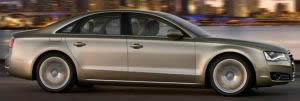 |
| Audi A8 was the first mass production car featuring Aluminium Space Frame (ASF) chassis. Developed in conjunction with US aluminium maker Alcoa. ASF is intended to replace conventional steel monocoque mainly for the benefit of lightness. |
Audi claimed A8's ASF is 40% lighter yet 40% stiffer than contemporary steel monocoque. This enables the 4WD-equipped A8 to be lighter than BMW 740i.
ASF consists of extruded aluminium sections, vacuum die cast components and aluminium sheets of different thicknesses. They all are made of high-strength aluminium alloy. At the highly stressed corners and joints, extruded sections are connected by complex aluminium die casting (nodes). Besides, new fastening methods were developed to join the body parts together. It's quite complex and production cost is far higher than steel monocoque.
 |
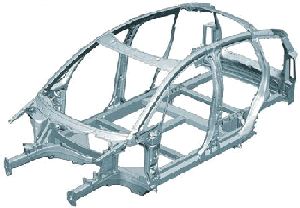 |
Audi A2 and his spaceframe in CAD |
The Audi A2 employed the second generation of ASF technology, which involves larger but fewer frames, hence fewer nodes and requires fewer welding. Laser welding is also extensively used in the bonding. All these helped reducing the production cost to the extent that the cheap A2 can afford it.
Advantage if this construction is that is lighter than steel monocoque and as space efficient as it is.
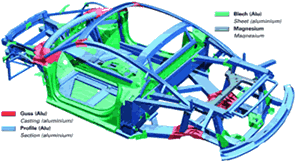 |
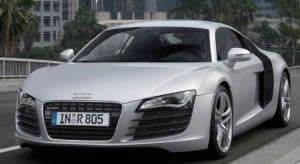 |
Audi R8 high class sport car |
|
Audi employ same technology 2009 for new Audi R8 high performance sport car. More elaborated and technically more efficient production, but is still to expensive for mass production.
Monocoque
In contrast to Spaceframes, the monocoque chassis uses panels, just like the sides of the box pictured above. Instead of small tubes forming the shape of a box, an entire panel provides the strength for a given side.
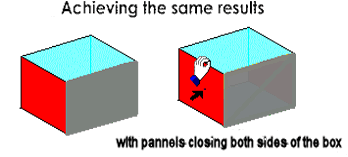
A common shape for 1960s racing cars of monocoque construction was the "cigar". The cylindrical shape helped impart something called Torsional rigidity. Torsional rigidity is the amount of twist in the chassis accompanying suspension movement. See the diagram below.

Monocoque, from Greek for single (mono) and French for shell (coque) (monoshell), is a construction technique that supports structural load by using an object's external skin as opposed to using an internal frame that is then covered with a non-load-bearing skin. Monocoque construction was first widely used in aircraft in the 1930s. Structural skin or stressed skin is other terms for the same concept. A welded unit body is the predominant automobile construction technology today.
 Today, 99% cars produced in this planet are made of steel monocoque chassis, thanks to its low production cost and suitability to robotized production.
Today, 99% cars produced in this planet are made of steel monocoque chassis, thanks to its low production cost and suitability to robotized production.
Monocoque is a one-piece structure which defines the overall shape of the car. In fact, the "one-piece" chassis is actually made by welding several pieces together. The floorpan, which is the largest piece, and other pieces are press-made by big stamping machines. They are spot welded together by robot arms (some even use laser welding) in a stream production line. The whole process just takes minutes. After that, some accessories like doors, bonnet, boot lid, side panels and roof are added.
Monocoque chassis also benefit crash protection. Because it uses a lot of metal, crumple zone can be built into the structure. Another advantage is space efficiency. The whole structure is actually an outer shell, unlike other kinds of chassis, therefore there is no large transmission tunnel, high door sills, and large roll over bar etc. Obviously, this is very attractive to mass production cars.
There are many disadvantages as well. It's very heavy, thanks to the amount of metal used. As the shell is shaped to benefit space efficiency rather than strength, and the pressed sheet metal is not as strong as metal tubes in spaceframe construction or extruded metal, the rigidity-to-weight ratio is also the lowest among all kinds of chassis bar the ancient ladder or backbone chassis.
Although monocoque is suitable for mass production by robots, it is nearly impossible for small-scale production. The setup cost for the tooling is too expensive - big stamping machines and expensive moldings.
Carbon-Fiber Monocoque
Carbon Fiber is the most sophisticated material using in aircrafts, spaceships and racing cars because of its superior rigidity-to-weight ratio and very high price.
In the early 80s, FIA established Group B racing category, which allowed the use of virtually any technology available as long as a minimum of 200 road cars are made. As a result, road cars featuring Carbon-Fiber body panels started to appear, such as Ferrari 288GTO and Porsche 959.
Production process
Carbon-fiber panels are made by laying carbon-fiber sheets (something look like textile) in either side of an aluminium or kevlar paper honeycomb inserts. The honeycomb, which defines the shape of the panel, is sticked with several layers of carbon fiber sheets impregnated with resin, then cooked in a big oven at 120°C and 6 bar (90 psi) pressure. After that, the carbon fiber composite will be melted and form a uniformal, rigid body panel.
The use of composite materials in monocoque skins now allows strength, stiffness and flexibility to be controlled in different fiber directions. Careful design of the direction of the fibers of successive layers of materials used in the skin can produce different mechanical properties in different directions while optimizing for weight. Composite materials can be readily built up into complex three-dimensional shapes making them ideal for many components. They can also be built to be flexible only in useful ways.
There are several fibers types commonly used in motor industry. Kevlar, which was developed by Du Pont, offers the highest rigidity-to-weight ratio among them. Kevlar can also be found in the body panels of many exotic cars as antiintrusion protection. Carbon-fiber is used in even larger amount. You can find glass fiber for less expensive but still strong parts. Aluminum honeycomb panels are often in use for monocoque construction as part of composite structure or as loaded part by itself.
The large number and types of functional demands for the monocoque, coupled with the multiple plies needed for the carbon or any other composite laminate, create a complex loading situation that require detailed static and dynamic analysis capabilities. Engineering teams are using sophisticated software to do the job in optimizing the design of the monocoque chassis and engine frames. Finite element analysis (FEA) programs used by many automotive companies for its ability to model multiple materials and to simulate short duration impact dynamics and complex contact conditions among multiple components are used. Software can help to determine optimum locations for attachment points and orientation of the fibers.
Use of a carbon/epoxy monocoque is, therefore, a huge advantage in terms of parts integration, giving design freedom to customize the laminate at the attachment points to avoid undue stresses or delamination.
Carbon-Fiber Panels VS Carbon-Fiber Monocoque Chassis
Porsche 959, employed carbon-fiber in body panels only, is obviously inferior to McLaren F1's carbon-fiber monocoque. This structure not only supports the engine / drivetrain and suspensions, it also serves as a very rigid survival cell.
Exotic car makers like to tell you their cars employ carbon-fiber in construction. This sounds very advanced, but you must ask one more question - where is the carbon-fiber used ? Body panels or chassis?
Most so-called "supercars" use carbon-fiber in body panels only, such as Porsche 959, Ferrari 288GTO, Ferrari F40 and even lately, the Porsche 911 GT1. Since body panels do almost nothing to provide mechanical strength, the use of carbon fiber over aluminium can barely save weight. The stress member remains to be the chassis, which is usually in heavier and weaker steel tubular frame.
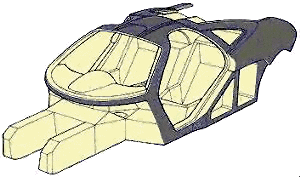 |
Carbon fiber monocoque chassis of McLaren F1 sport car |
What really sophisticated is carbon-fiber monocoque chassis, which had only ever appeared in McLaren F1, Bugatti EB110SS (not EB110GT) and Ferrari F50. It provides superior rigidity yet optimize weight. No other chassis could be better.
Carbon Fiber Monocoque made its debut in Formula 1 1981 with McLaren's MP4/1 Formula One racing car, designed by John Barnard. No wonder McLaren F1 is the first road car to feature it.
Unlike McLaren F1, Ferrari F50's rear suspensions are directly bonded to the engine/gearbox assembly, same as in modern Formula 1 car. This means the engine becomes the stressed member which supports the load from rear axle. Then, the whole engine/gearbox/rear suspensions structure is bonded into the carbon fiber chassis through light alloy. This was a first for a road car.

